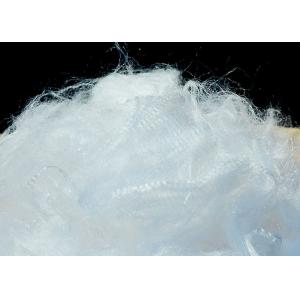
Add to Cart
Bicomponent Natural Pla Staple Fiber With High Quality
PLA Degradable Fiber 1.5D For Medical Nonwoven
1 . Descriptions:
PLA biodegrades slowly in this way - Initially polymer chain of 100,000 to 300,000 molecular weight, break down into its constituent parts (Carbon dioxide and water) within three months in a "controlled composting environment". While compounding polymer if heat of 75C applied at steady rate helps the microbes to decompose in controlled environment. But it will take far longer in a compost bin and in a tightly packed landfill where no light and presence of oxygen are rare available to assist in the process. Indeed, analysts estimate that a bottle grade PLA may take approximate time from 100 to 1,000 years to decompose in soil. Conventional PET polymer contains molecular weight of 170,000 to 350,000 hence it is highly tough to decompose.
2 . Specifications:
| No | Test | Unit | Data | ||
| 1 | Titre | dtex | 1.5. | ||
| 2 | Tenacity at break | cN/dtex | 3.55 | ||
| 3 | Elongation at break | % | 38.27 | ||
| 4 | Length | mm | 39.2 | ||
| 5 | Crimp number | number/25mm | 15 | ||
| 6 | Defect | mg/100g | / | ||
| 7 | Over-length fiber | mg/100 | 2 | ||
| 8 | Oil content | % | 0.2 | ||
| 9 | Dry thermal shrinkage | % | 5 | ||
| 10 | Moisture | % | - | ||
3. Advantages:
PLA is biodegradable under commercial composting conditions and will breakdown within twelve weeks, making it a more environmentally choice when it comes to plastics in contrast to traditional plastics which could take centuries to decompose and end up creating microplastics.
PLA filaments are mainly produced by two-step melt spinning to get fibers with stable quality, but degradation at high temperature is still a problem. PLA staple yarns are normally spun using ring spinning.
Currently existing knitting or weaving techniques can be used to produce PLA fabrics. PLA fabrics can be dyed with disperse dyes at 110°C, but their color fastness and shades are different from PET fabrics when using the same dyes.
The scouring and dyeing of PLA/cotton blended fabrics and the reductive clearing after dyeing remain to be improved. As a new fiber, the entry of PLA fiber into the textile market faces difficult challenges as well as great opportunities in the future.
4 . More pictures:
